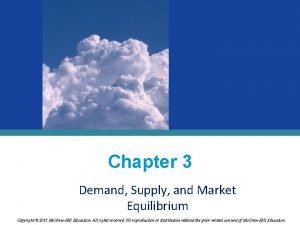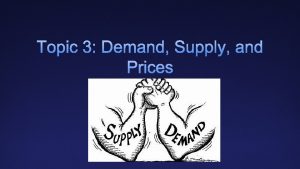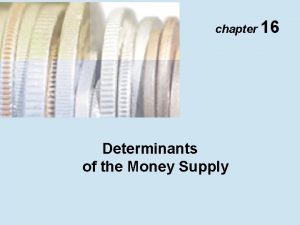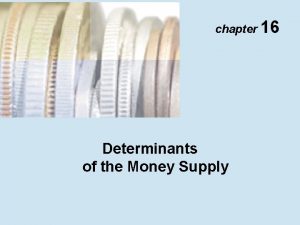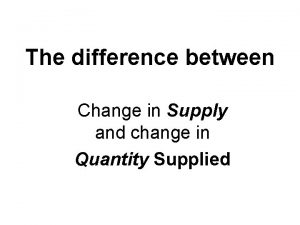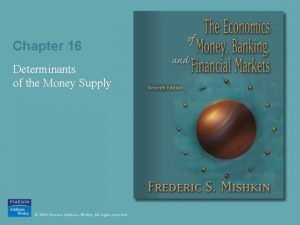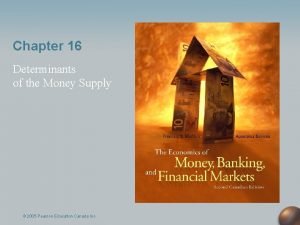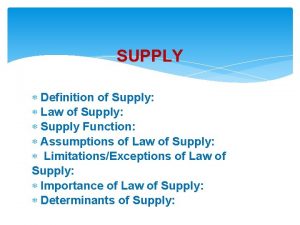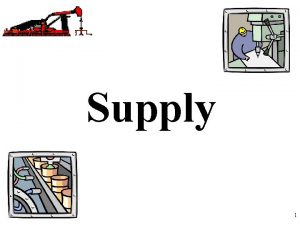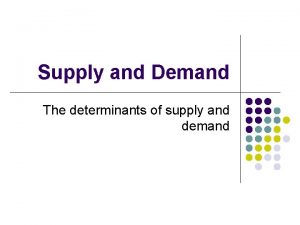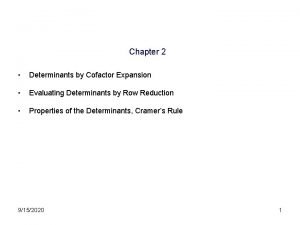Changes in Supply 4 2 Determinants of Supply









- Slides: 9

Changes in Supply 4. 2 Determinants of Supply: Factors other than price that can change or shift the supply curve. 1. 2. 3. 4. 5. 6. Prices of Resources— Government Tools Technology Competition Prices of related goods Producer Expectations

Determinants of Supply Prices of Resources--=Raw materials, electricity, workers wages, etc. n n Any of these can increase or decrease a business’s production costs. Lower costs=higher profits Producers can supply more product Supply curve shifts to the right

Government Tools 4. 2 Taxes, Subsidies, and Regulation n n n Tax-Required money paid to the government to help fund services. Taxes add to a business’s production costs Higher taxes=higher production costs Higher production costs=lower profits Subsidies—Payments to private businesses. Ex. Wheat farmers—Encourages more

Government Tools 4. 2 Regulation—Rules that the government passes about how companies conduct business. n n n Ex. Pollution, Safety, Strict rules—cost $ and reduce supply Loose rules—cost less $ increase supply

Technology 4. 2 Powerful tool that makes production more efficient and less expensive. Ex. Automobiles— n n n 1900 made 1 at a time Assembly line invented Costs went down—more profitable—more supply

Competition 4. 2 Competition increases supply Lack of competition decreases supply Why? Demand for product grows Encourages competitors to enter market Supply curve shifts to the right

Prices of Related Goods 4. 2 The supply for one good is connected to the supply for its related goods. Ex. Wheat Farming n n Price of wheat falls Price of corn is up Choose to grow corn instead Supply of wheat down/Corn supply up

Producer Expectations 4. 2 The expectations suppliers have of future changes in the price of their products can affect how much to supply now of a product. Ex. Basketballs—Start of school year n Demand low now—but will increase in November n So, company increases supply now to meet expected November demand n Supply curve shifts to the right

The Chicken Farm Exercise I. Supply: 10 chickens x 5 Eggs/wk. =50/12=4. 2 Dz Demand: 10 Dz. /Wk. n Demand>Supply; Scarcity/Surplus? Price? Supply? II. Supply: 30 x 5=150/12=12. 5 Dz. Demand: 10 Dz. /Wk. Supply>Demand; Scarcity/Surplus? n Price? Supply?
 Changes in latitudes, changes in attitudes meaning
Changes in latitudes, changes in attitudes meaning Sample of chemical changes
Sample of chemical changes 5 determinants of supply
5 determinants of supply Non price determinants of supply
Non price determinants of supply Chapter 16 determinants of the money supply
Chapter 16 determinants of the money supply Chapter 16 determinants of the money supply
Chapter 16 determinants of the money supply Non price determinants of supply
Non price determinants of supply Chapter 16 determinants of the money supply
Chapter 16 determinants of the money supply Deposit multiplier
Deposit multiplier Non price determinants of supply
Non price determinants of supply


